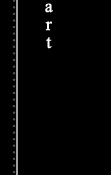




{enter gallery above} “A long duration is sublime. If it concerns past time it is noble; if anticipated as an indeterminable future, it has something terrifying.” - Immanuel Kant, The Sense of the Beautiful and the Sublime I’m not completely certain that Forrest Harrison Gerke spends much of his days in contemporary times. In his head, at least. For if his work is any indicator, Gerke has spent the bulk of his time in the past. He has explicitly reached backwards, into antiquity, to grasp the lessons and sounds, poetics and aesthetics of a sepia time long gone by. In so many different ways Gerke has stretched back into the darkened past of our human history: through his degrees in painting and art history, through his taste in music and aesthetics, and nearly everything about his current body of work. As such, to begin talking about Gerke’s current work, appropriately – we must turn part of our clocks backwards: In the 18th century, Immanuel Kant and Edmund Burke popularized an idea that centered around ideas of the beautiful and the sublime. Relative to Forrest Gerke’s work, the notion can be articulated as the idea that says: the collective human consciousness is oftentimes attracted to things that are obscured; and less than easy to digest. The more something is hidden, or obscured, the more people will come back to look for it, to decipher it, to try and find meaning in it. In his essay on the beautiful and sublime, Kant writes, “(t)he sublime moves.” Kant believed that, “the expression of a person experiencing the full sense of the sublime is serious, at times rigid and amazed.” Furthermore: “The sublime, in turn, is at times accompanied by some terror or melancholia, in some cases merely by quiet admiration and in still others by the beauty which is spread over a sublime place. The first I want to call the terrible sublime, the second the noble, and the third the magnificent. Deep loneliness is sublime, but in a terrifying way.” Forrest Harrison Gerke’s work is layered. Textured. Beneath initial layers there are deeper contexts; words; pages from books. In this, Gerke mirrors and articulates the Kantian notion that people are often attracted to what is obscured; to what they have to work a little harder to piece together and create meaning from. But, this simple mechanism is by no means the only way he is playing with this complicated notion. Gerke’s artwork is personal, but still, he feels impetus to share it with others. Personally and publicly, Gerke is interested in investigating the beautiful and the sublime. Implicitly, he knows that his skill sets can create work that moves others. However, there is a vulnerability within this: that he will poke too many holes in his walls, exposing his private, inner world. In the end, Gerke doesn’t want to just let anybody and everybody into that secret, darkened space that he has filled with libraries of experience, pictures and ideas. So, one way that he has gone about sustaining this private, solitary space is by obscuring things in the sharing process, in his work, in a way that maintains his personal integrity. And one of the mechanisms he has employed is the element of layering, of obscuring some of the words, and certainly – by obscuring some of the meanings; and letting the audience decipher and conclude what they may. Forrest Harrison Gerke’s work isn’t archival. It will fade, darken with time. Physically, his work is a bit more ephemeral. Yet, as he has pulled from all of previous human experience – the lessons, ideas and virtues – he also has pulled out the idea that the sublime ideas rise and maintain buoyancy that endures time. In part, Gerke’s work is about the physical objects that he creates, but mostly – it’s about the ideas, the layers, and what lays underneath of everything, and everyone. Stay abreast of Gerke’s upcoming shows and work, here: http://web.mac.com/forrestgerke/Forrest_Harrison_Gerke/Forrest_Harrison_Gerke.html |









